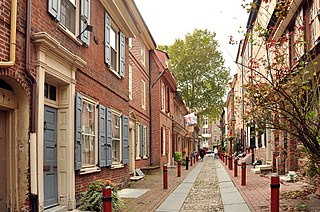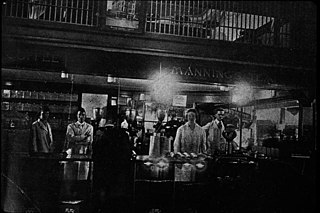
The National Register of Historic Places (NRHP) is the United States federal government's official list of districts, sites, buildings, structures, and objects deemed worthy of preservation for their historical significance or "great artistic value". A property listed in the National Register, or located within a National Register Historic District, may qualify for tax incentives derived from the total value of expenses incurred in preserving the property.

The Lake Washington Ship Canal is a canal that runs through the city of Seattle and connects the fresh water body of Lake Washington to the salt water inland sea of Puget Sound. The Hiram M. Chittenden Locks accommodate the approximately 20-foot (6.1 m) difference in water level between Lake Washington and the sound. The canal runs east–west and connects Union Bay, the Montlake Cut, Portage Bay, Lake Union, the Fremont Cut, Salmon Bay, and Shilshole Bay, which is part of the sound.

The New York City Landmarks Preservation Commission (LPC) is the New York City agency charged with administering the city's Landmarks Preservation Law. The LPC is responsible for protecting New York City's architecturally, historically, and culturally significant buildings and sites by granting them landmark or historic district status, and regulating them after designation. It is the largest municipal preservation agency in the nation. As of July 1, 2020, the LPC has designated more than 37,800 landmark properties in all five boroughs. Most of these are concentrated in historic districts, although there are over a thousand individual landmarks, as well as numerous interior and scenic landmarks.

Historic districts in the United States are designated historic districts recognizing a group of buildings, archaeological resources, or other properties as historically or architecturally significant. Buildings, structures, objects, and sites within a historic district are normally divided into two categories, contributing and non-contributing. Districts vary greatly in size and composition: a historic district could comprise an entire neighborhood with hundreds of buildings, or a smaller area with just one or a few resources.

In the law regulating historic districts in the United States, a contributing property or contributing resource is any building, object, or structure which adds to the historical integrity or architectural qualities that make the historic district significant. Government agencies, at the state, national, and local level in the United States, have differing definitions of what constitutes a contributing property but there are common characteristics. Local laws often regulate the changes that can be made to contributing structures within designated historic districts. The first local ordinances dealing with the alteration of buildings within historic districts was enacted in Charleston, South Carolina in 1931.

Manning's Cafeterias was a chain of about 40 cafeteria-style restaurants in nine western U.S. states. The chain started in Seattle's Pike Place Market in 1908; that location became Lowell's in 1957 and is still in operation. Another one in Ballard, a suburb of Seattle, was constructed in 1964 in the futuristic Googie architectural style, reopened as a Denny's in 1984 and was designated a City of Seattle Landmark by the Landmarks Preservation Board on February 20, 2008.
The City of Omaha Landmarks Heritage Preservation Commission, established in 1977, is the Omaha city government's a nine-member board responsible for recommending official Omaha Landmarks to the Omaha City Council. The Landmarks Heritage Preservation Commission is that was established by ordinance in 1977 to review and recommend to the City Council on all matters pertaining to the designation of individual buildings, sites, objects, or entire districts of local historical significance. The commission is staffed by the Landmarks Division of the Omaha Planning Department.

Pike Place Market is a public market in Seattle, Washington, United States. It opened on August 17, 1907, and is one of the oldest continuously operated public farmers' markets in the United States. Overlooking the Elliott Bay waterfront on Puget Sound, it serves as a place of business for many small farmers, craftspeople and merchants. It is named for its central street, Pike Place, which runs northwest from Pike Street to Virginia Street on the western edge of Downtown Seattle. Pike Place Market is Seattle's most popular tourist destination and the 33rd most visited tourist attraction in the world, with more than 10 million annual visitors.

Designated a Seattle, Washington Landmark, the Norvell House was built in 1908 and is a late example of the Swiss chalet style of Architecture. Located in the community of Ballard, in the vicinity of Sunset Hill, it sits on its original-sized lot with impressive heritage trees and retains its flanking carriage house.

The Naval Reserve Armory is a landmark building in the South Lake Union neighborhood of Seattle, Washington, United States. Since 2012, it has been the home of the Museum of History and Industry (MOHAI), a local history museum.

The architecture of Seattle, Washington, the largest city in the Pacific Northwest region of the U.S., features elements that predate the arrival of the area's first settlers of European ancestry in the mid-19th century, and has reflected and influenced numerous architectural styles over time. As of the early 21st century, a major construction boom continues to redefine the city's downtown area as well as neighborhoods such as Capitol Hill, Ballard and, perhaps most dramatically, South Lake Union.

The Neptune Theatre, formerly known as U-Neptune Theatre, is a performing arts venue in the University District neighborhood of Seattle, Washington, United States. Opened in 1921, the 1,000 capacity venue hosts a variety of events, including dance and music performances, film screenings, and arts education. It was primarily used for screening classic films prior to a 2011 renovation. In 2014, the theater and building were designated a Seattle landmark.

The Glendale Register of Historic Resources and Historic Districts consist of buildings, structures, bridges, statues, trees, and other objects designated by the City of Glendale, California, as significant historic resources or historic districts.
The Columbus Register of Historic Properties is a register for historic buildings and other sites in Columbus, Ohio, United States. The register is maintained by the City of Columbus Historic Resources Commission and Historic Preservation Office, and was established in 1980. Many of these landmarks are also listed on the National Register of Historic Places, providing federal tax support for preservation, and some are further designated National Historic Landmarks, providing additional federal oversight.

The Colonnade Hotel first known as the Stimson Block then later the Standard Hotel, Gateway Hotel and Gatewood Hotel is a historic hotel building in Seattle, Washington located at the Southeast corner of 1st Avenue and Pine Streets in the city's central business district. One of the earliest extant solo projects of architect Charles Bebb, it was built in 1900 by Charles and Fred Stimson, owners of the Stimson lumber mill at Ballard, for use as a hotel. It served that purpose under its various names until the early 1980s and after a brief vacancy was restored into low-income housing by the Plymouth Housing Group. Once owned by the Samis Foundation, it was sold to various LLC owners who would convert it back into a hotel in 2017, currently operating under the name Palihotel. It was added to the National Register of Historic Places on August 7, 2007 and became a City of Seattle Landmark in 2017.

The Ballard-Howe House is a historic residence located in the neighborhood of Queen Anne in Seattle, Washington. The house was listed on the National Register of Historic Places on March 26, 1979. It was one of the first Colonial Revival-style homes built in the Seattle area that remains today.


























